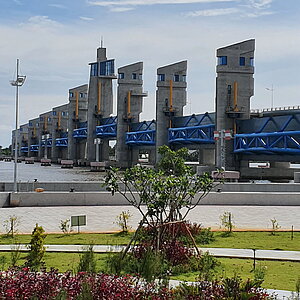How Costa Rica is handling climate risks

Six years after the start of the CSI project, efforts made at both a policymaking and technical level are bearing fruit: Costa Rica now has its own toolset as well as the institutional requirements in place that allow it to better meet climate risks to infrastructure in the future.
A PowerPoint slide shows the Puente sobre el río General Viejo, a bridge in the San Isidro del General region in southwestern Costa Rica. Six photos, snapshots taken from 2008 to 2019: on each photo, the bridge is again destroyed – by the hurricanes and heavy rains that caused the river to burst its banks. “That was our starting-point,” says Vladimir Naranjo as he begins his presentation. It’s a rainy day in Vancouver, Canada, in April 2023. Naranjo is a member of the Costa Rican delegation to the first global forum of the international expert network on climate risk assessment for infrastructure. “We were tired of simply being passive bystanders to the destructive effects of extreme weather on our infrastructure.” With this comment, Naranjo, an engineer with the Costa Rican engineering association CFIA (Colegio Federado de Ingenieros y de Arquitectos de Costa Rica), is talking about the start of the IKI project “Improved Climate Services for Infrastructure Investment (CSI)”, which was launched as a joint initiative in 2017 by an expert committee made up of various ministries and federations to improve the climate resilience of infrastructure in Costa Rica.
Six years later, in February 2023, two Costa Rican ministers – Minister for Transport Luís Amador and Minister for the Environment Franz Tattenbach – attend a signing ceremony for a document that will be the key to achieving this goal: “Metodología de Evaluación de Riesgo Climático de Infraestructura de Costa Rica” – “MERCI-CR” for short – is a methodology for measuring climate risks to infrastructure and deriving recommendations for action. The document is the result of six years of interdisciplinary work from a group led by MINAE, the Environment Ministry. Alongside CFIA, experts from Costa Rica’s weather service and Transport Ministry (MOPT) were also involved.
A new method based on a Canadian model
MERCI is based on the Canadian Public Infrastructure Engineering Vulnerability Committee Protocol (PIEVC), named after the committee responsible for its development. Deployed successfully in Canada since 2009, PIEVC has now achieved international recognition with the CSI project. Sharing insights on this model is the agenda for this April 2023 meeting in Vancouver, the first conference of the PIEVC Practitioners‘ Network, attended by more than 150 delegates from 11 countries seeking to protect their domestic infrastructure from climate change.
While Costa Rica was not the first country to apply the PIEVC model internationally, it was the first to take things one step further: Naranjo’s working group wanted their own toolset, fine-tuned to the conditions and challenges of their native land. Although Canada and Costa Rica are both affected by the impacts of climate change, key differences exist between the two countries: relevant climate services (application-focused climate data) are patchy in Costa Rica and expensive to use even when available. MERCI is therefore specifically designed to survey and process climate risks despite various uncertainties and the absence of data.
Iván Delgado, now Director of the Climate Adaptation Department at MINAE and a long-standing negotiator at international climate negotiations, expresses his exasperation at the interim negotiations in Bonn in June 2023. “For years now, we have been going round in circles and only talking about the ‘immense challenges’. Could we not finally start talking about solutions? And we have a solution – it’s called MERCI.”
Climate risk assessments for infrastructure enshrined in National Adaptation Plan

Deploying this solution is entirely dependent on policymaking decisions from Delgado’s own ministry: after MINAE issued a decree on resilient infrastructure in 2018, the ministry then enshrined climate risk assessments for infrastructure within its new National Adaptation Plan in 2022. For CFIA, this means, above all, a lot of work. Accordingly, a dedicated climate change department – which Naranjo now heads – was set up with the help of the CSI project.
Soon enough, MERCI got the opportunity for its first real-world trial. As part of another adaptation project, Naranjo and his colleagues were assessing climate risks in seven communities in the Dota region, in northern Costa Rica. Here, MERCI helped them to identify the vulnerability of the road network as a potential problem for supplying water to these communities. To mitigate these risks, reforestation work is planned in the surrounding forests to prevent the landslides that would otherwise threaten these roads. As can be seen, MERCI is not merely a toolset whose use is limited to infrastructure: its integrated approach allows it to identify ecosystem-based adaptation measures – such as the reforestation strategy necessary to stabilise the hillsides in the Dota region. Often, measures like these are not only cheaper than many infrastructure projects but also offer other benefits – such as carbon sequestration and improved air quality – leading to a better quality of life for local communities.
CFIA has simultaneously received enquiries from other adaptation projects in the country who want to use MERCI. The National Audit Office, already very interested in climate risk management for infrastructure at the outset of the CSI project and which supported many of the policymaking processes, has now established MERCI as the standard for assessing risks to new public infrastructure. Interest has also been shown by many other countries in the region – CFIA has been invited to visit Guatemala to share its insights, for example. Feedback from the audience at the forum in Vancouver confirmed the fact that the world is interested in Costa Rica’s pioneering approaches to climate change adaptation.
“We quickly realised that we simply can’t complete all of these risk assessments ourselves,” Naranjo explains. A train-the-trainer approach is needed to meet this growing demand. This is why CFIA’s climate change department is working hard to set up a CPD course on MERCI while simultaneously cooperating with the University of Costa Rica to integrate MERCI into its engineering degrees. The overall aim is to increase the pool of experts able to use MERCI. Not least because it is clear that demand will continue to rise: indeed, CFIA has just recommended that MINAE develop new legislation for climate change-adapted infrastructure. Once adopted, all new infrastructure projects will need to consider climate risks to receive planning permission. Naranjo and his team are working to ensure that Costa Rica’s engineers are prepared for this future scenario.
The link has been copied to the clipboard
Contact
IKI Office
Zukunft – Umwelt – Gesellschaft (ZUG) gGmbH
Stresemannstraße 69-71
10963 Berlin


















